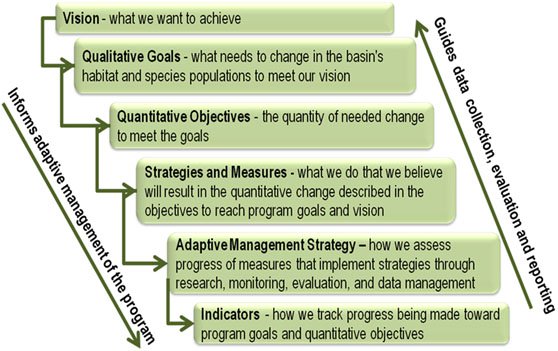The program aims to rebuild healthy, naturally producing fish and wildlife populations adversely affected by the construction and operation of hydroelectric dams in the Columbia River Basin. It accomplishes this by protecting, mitigating, and enhancing habitats and biological systems.
Existing reports[1] provide a framework for understanding the magnitude of salmon and steelhead losses. Mitigating for the loss of other anadromous fish, such as lamprey and eulachon, and native resident fish such as bull trout, cutthroat trout, kokanee, and sturgeon, is equally important [see program strategies: lamprey, eulachon, wild fish, resident fish mitigation, mainstem hydrosystem flow and passage operations.] The program also maintains a commitment to mitigate for wildlife losses.
The program includes qualitative goal statements and quantitative objectives to prioritize the work. The program continues to include a set of quantitative goals and related timelines for anadromous fish. These include, among others, increasing total adult salmon and steelhead runs to an average of 5 million annually by 2025 in a manner that emphasizes the populations that originate above Bonneville Dam and supports tribal and non-tribal harvest, and achieves smolt-to-adult return rates in the 2-6 percent range (minimum 2 percent; average 4 percent) for listed Snake River and upper Columbia salmon and steelhead. As part of an effort to refine objectives, the region should also consider the ISAB’s recommendation to redefine the 2 to 6-percent smolt-to-adult ratio (SAR) objective to reflect the survival of populations needed to achieve recovery and harvest goals. The ability of the region to achieve these goals will depend on the coordinated actions of many parties to improve fish habitat and passage, improve hatchery operations, and limit harvest of potential spawners. The qualitative goal statements describe the changes needed to achieve the program’s basinwide vision. Progress in achieving these qualitative goal statements is measured using quantitative objectives. The vision and goal statements guide the development of the objectives (see Figure 4 for an overview of this format).
How progress is monitored and evaluated is described in the adaptive management strategy. It’s also reported using fish and wildlife indicators on the subbasin dashboard and the high-level indicators in the program’s High-Level Indicator report. These program-level goals and objectives also provide guidance for subbasin-level and other goals and objectives. Achieving these quantitative objectives depends on the coordinated actions of many parties.
Principles guiding the program goals and objectives
Program goals and objectives should be:
- Consistent with the program vision statement
- Designed to achieve the ecosystem functions necessary to restore healthy, self-sustaining, and harvestable populations of native fish and wildlife in the Columbia River Basin
- Designed to provide a measurement of program success by achieving the program’s fish species and population abundance, productivity, spatial distribution, and diversity objectives.
- Implemented in a manner that allows sufficient monitoring and evaluation, and provisions for adaptive management, to ensure that progress toward objectives can be tracked, and that future management can respond to new information and strategies.
Themes for program goals and objectives[2]
Theme One: Protect and enhance habitat to provide a home for species
Theme Two: Ensure species survival by promoting abundance, diversity and adaptability
Theme Three: Compensate for a wide range of hydrosystem impacts
Theme Four: Engage the public

Figure 4. Linkages between program vision, goals, objectives, and indicators track how successful program strategies are progressing toward the goals and objectives. This figure is an expansion of a subcomponent of the program framework [see program framework]
[1]“Compilation of Salmon and Steelhead Losses in the Columbia River Basin” (Appendix D of the Council’s 1987 Fish and Wildlife Program), “Numerical Estimates of Hydropower-related Losses” (Appendix E of the 1987 Program), and “Compilation of Information on Salmon and Steelhead Total Run Size, Catch and Hydropower-Related Losses in the Upper Columbia River Basin, Above Grand Coulee Dam”
[2] The term ‘Biological Objectives’ is used in the program when referring to the environmental characteristics and biological performance goals and objectives in themes one and two.


